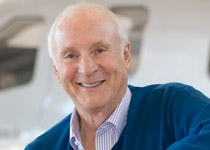Proficient Pilot: Name-dropping
Memorable passengers for the books
What a great idea, I thought. Highlighting one’s logbooks with autographs of those we meet along the way certainly would make them even more meaningful.
I began my career with TWA in 1964. This was during the era of the jet-setter, when celebrities rode first-generation jetliners. It was before business jets evolved and lured them away from airline travel. It was when preflight and dispatch paperwork included a list of VIPs who would be riding on our flights—there were always some.
I was a co-pilot in TWA’s International Division in 1967. We were en route to Paris somewhere over the Atlantic during the middle of an April night. The captain adjusted his tie, slid his seat back, and announced that he was going for a walk, something that airline pilots were allowed and even encouraged to do in those days. We called it the cabin tour. Passengers seemed to enjoy seeing their pilot, and it was almost impossible to get to the tail without some of them asking who was flying the airplane.
Upon his return, the captain told me that he had had a nice chat with an elderly gentleman in 2-B. While later taxiing to the gate, a flight attendant entered the cockpit and handed the captain a folded piece of TWA’s in-flight stationery. It was from 2-B, some sort of strange drawing of our Boeing 707 that had been signed by a Mr. Pablo Picasso. I’ve thought many times over the years how nice it would have been to have had his autograph in my logbook (along with a small sketch, if you don’t mind, please).
That same captain collected the autographs of many of his famous passengers. Years later when he was flying the Boeing 747, he was informed that the entire upper deck of first-class seats on his flight from London to Los Angeles had been reserved for only two passengers who obviously cherished their privacy. The captain received a note from Elizabeth Taylor and Richard Burton thanking him for his “hospitality.” This note obviously found its way into his logbook.
Shortly after earning my fourth stripe in 1968, I was told by a flight attendant that one of our passengers was a visibly distressed fearful flyer. She asked if I’d go aft to offer him some words of comfort. I found Charles Boyer, the famed French-American actor, fingering beads and in obvious discomfort. We chatted for a while, and he did seem to calm down somewhat. He later sent a note of thanks to the cockpit, but I regrettably failed to keep it.
During 1975, I spent two weeks in Binghamton, New York, getting trained in the Link Division of Singer’s first Lockheed L–1011 simulator. During my days off, I drove to nearby Elmira to do some soaring. While in a long line of pilots waiting patiently in their sailplanes to be towed aloft, I noticed the pilot ahead of me growing weary of the wait. He climbed out of his cockpit, wiped his brow, took a swig of bottled water, and walked toward me to pass the time and chat about soaring. I only wish that I had had the presence of mind to ask for this glider pilot’s autograph. I would have liked to have had rocket pioneer Wernher von Braun’s signature in my soaring logbook.
It’s probably a bit late now to think about adding autographs to my logbooks, but it sure would have been nice to have had my logbooks signed by many of the greats I have been blessed to meet. These included Eddie Rickenbacker, Jimmy Doolittle, Neil Armstrong, Donald Douglas, Bill Lear, Pappy Boyington, and many others.
I couldn’t have obtained the autographs of all of my memorable passengers, though. Some were live lobsters that I was bringing home from Boston and that I allowed to claw around freely on the cockpit floor, patiently awaiting the first unsuspecting flight attendant to step onto the flight deck and issue forth a blood-curdling scream.
Irrespective of whose autographs I could have collected, the most important signature would always belong to Steve Occhipinti, the CFI who had the courage to proclaim in writing on June 23, 1954, that I was safe for solo.
Web: barryschiff.com



